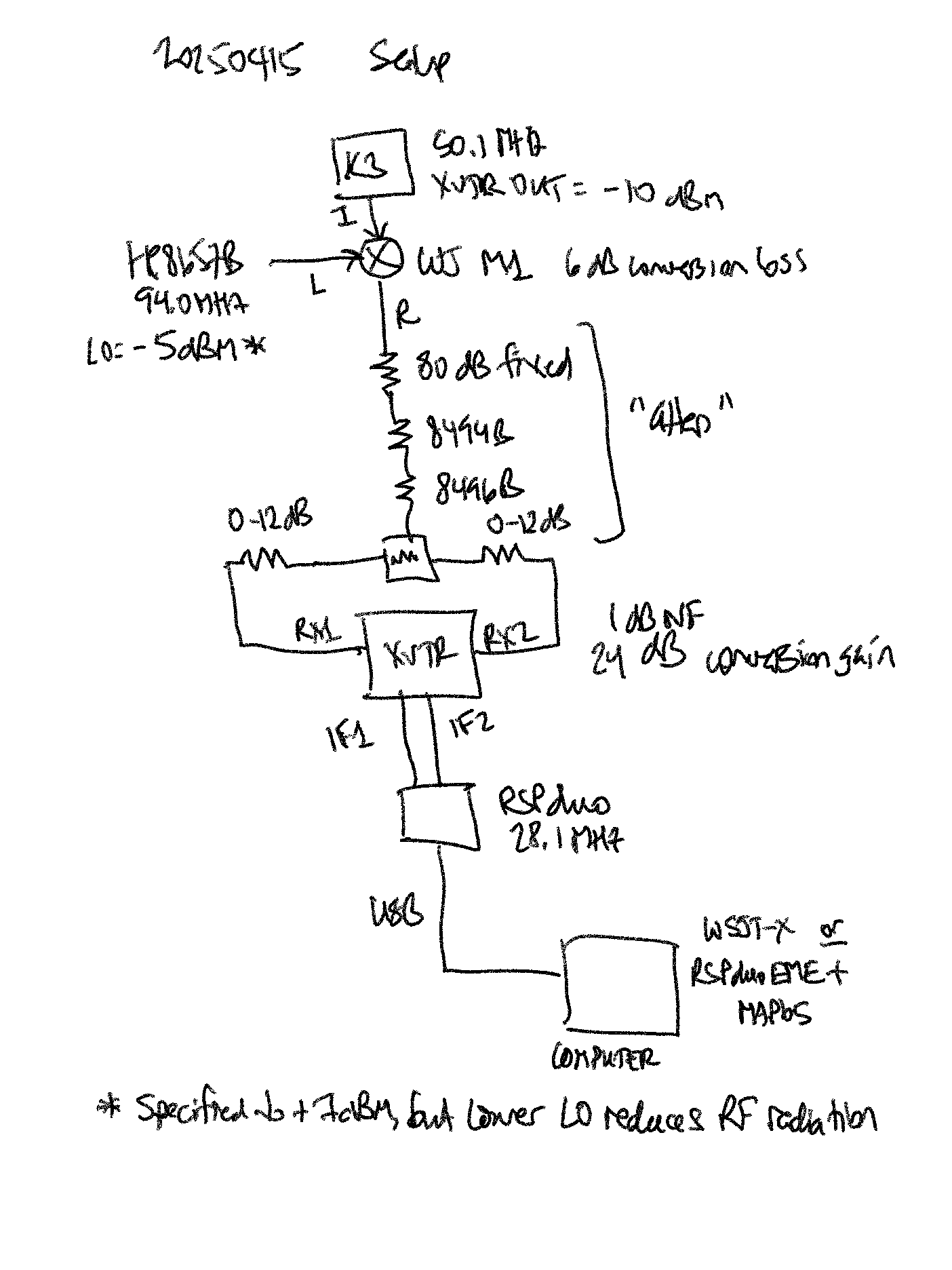NX7U
Scott Townley
Bridgewater, NJ
Bench testing the receive setup, including the software, has a lot of benefits:
1. Get used to how e.g. MAP65 behaves
2. Verify that your receive chain meets expectations
3. Compare different SDR/software implementations
There are a lot of SDR/software permutations out there. The original plan was to use AFEDRI SDR and LINRAD, but the learning curve on LINRAD is pretty steep...so many settings...and now there are various alternatives:
–RSPduoEME (from https://www.qsl.net/g4eev), which will drive MAP65 directly when using the RSPduo SDR from sdrplay.com
–AFEDRI SDR with SDR-Console software from SDR-radio.com
–others to be listed as I discover them
The main requirement is software that will take the SDR output and send it to MAP65 in .timf2 (LINRAD) format.
Below is my test setup:
I use the K3, mixer, and HP8657B to generate a 144.1 MHz JT65B signal (if I had a standalone 2m rig I could use that instead). One fabulous benefit of the K3 is that it can have XVTR IN/OUT ports (with the KXV3 option), and by setting the KXV3 mode as "Test" any TX signal comes out the XVTR OUT port at between -10 and +5 dBm.
One problem I had was leakage radiation at 144.1 MHz This condition is easily seen by the SNR reported by MAP65 not decreasing with a decrease in signal...at some point the leakage is stronger than the conducted signal and the attenuator setting becomes useless. In my case reducing the LO drive to the mixer did the trick. I also make sure to use quality, double-shielded cables and MIL connectors/adapters everywhere.
–Test 1: RSPduo running SDRuno software (1.42 1710), audio input to WSJT-X (2.7.0), single signal path.
This test was for sensitivity at the XVTR input. The calculated equivalent noise power density at the XVTR input was -139 dBm/2500 Hz. Sure enough WSJT-X reported 0 dB SNR at that signal power. The minimum consistently decoded level was at -165 dBm where WSJT-X variously reported -24 to -26 dB SNR.
–Test 2: RSPduo running RSPduoEME software (v 1.33) in Mode 3 (single signal path), USB input to MAP65 (3.0.1).
Rumor has it that MAP65 is a bit less sensitive than straight WSJT-X. This test was to see if that was true, and by how much.
My observations here were that MAP65 performed identically to straight WSJT-X. The reported SNR and ultimate sensitivity followed Test 1 ±1 dB.
–Test 3: RSPduo running RSPduoEME software in Mode 5 (dual signal path), USB input to MAP65.
Now the splitter, attenuators for each "polarization" path, and the "duo" part all come into play.
The polarization attenuators perform the following function:
–if RSPduo Tuner 1 is set to 0 dB and Tuner 2 is 12 dB (atten), MAP65 should report H polarization*. Note that the signal level at the SDR is 3 dB lower than that for Tests 1 and 2 for the same main attenuation value due to the loss through the splitter.
–If the attenuator settings are flipped, MAP65 should report V polarization*. Again, the signal level at the SDR is 3 dB lower than that for Tests 1 and 2 due to the splitter.
–If both attenuators are set to zero, MAP65 should report 45° polarization. In this case the main attenuation setting will match that of Tests 1 and 2, because in real life a wave arriving at 45° will be 3 dB down on each polarization path.
RESULTS:
–In the artificial single-path cases (0, 12 dB atten or 12, 0 on the two polarization paths), the measured MAP65 SNR was indeed 3 dB lower for the same value of main attenuation when compared to Tests 1 and 2. The reported polarization was very close to H (0°) and V (90°) as expected.
–When both polarization paths were set to 0 dB attenuation, the SNR increased by 3 dB and the reported polarization was very close to 45°.
–The ultimate sensitivity was the same as for Tests 1 and 2 (-165 dBm/2500 Hz or -26 dB).
CONCLUSION: MAP65 does not cost sensitivity, and does deliver on full polarization capability/elimination of Faraday rotation.
*if the RSPduo has had its phase calibrated, using the SET function in RSPduoEME.
Noise power calculation:
Passive Input network 288K
XVTR input 75K (1 dB NF)
rspDUO referred to XVTR input:
Input noise temp 9107 K (15 dB NF)
XVTR gain 25 dB
2nd stage contribution 29K
Total=288+75+29=392K
No=k*392*2500=-138.7 dBm/2500 Hz BW (same BW as WSJT-X/MAP65 SNR reporting)
Follow-up
WSJT-X and MAP65 were all at "default" settings above. Feedback indicated that the usual usage is different. Therefore I re-ran a single-polarization test with the following settings:
WSJT-X: enabled averaging, deep search, AP, and deep decode. Also have two-pass decoding checked, with random erasures=6 (this is a default) and aggressive level=6 (default is 0).
MAP65: set to aggressive deep search
Equipment was configured to deliver -166 dBm to the transverter input (or SNR of approximately -27 dB). The only thing that changed between runs was the receive software. Both receive configurations were sent 11 CQ messages. Results:
WSJT-X decoded 2/11 messages at reported SNRs of -30 and -28 dB.
MAP65 decoded 5/11 messages at reported SNRs of -26 or -27 dB.
It's probably worth setting up a longer run to get more statistical significance.
One thing worth mentioning is that I did notice that any messages decoded by MAP65 that were -27 dB reported SNR or below, were not transferred to the "Messages" pane. If the main window wasn't visible, you'd never know anything was decoded.
